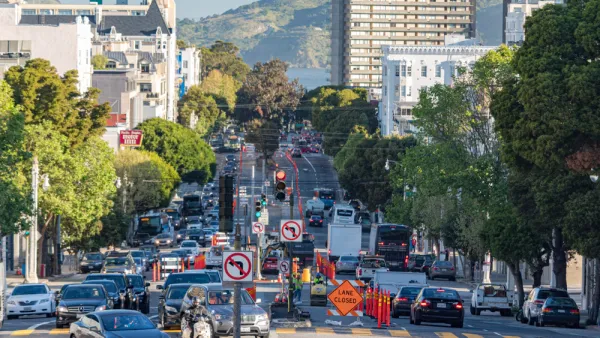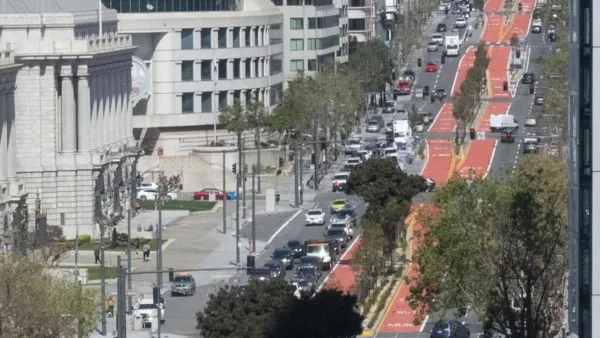While late to adopt bus rapid transit, San Francisco's Muni is planning to bring fully-fledged BRT lines, complete with dedicated lanes, to the city by 2010.
"Two bus rapid transit systems are already rolling in the Bay Area -- AC Transit's 72-R rapid bus along San Pablo Avenue in the East Bay -- and the Santa Clara Valley Transportation Authority's 522-Rapid between East San Jose and Palo Alto in the South Bay. Before the end of the year, AC Transit plans to launch a second speedy bus line from San Leandro to the UC Berkeley campus.
All three of those lines are minimalist versions of true bus rapid transit, relying on fewer bus stops and traffic signal. The most efficient bus rapid transit systems also have completely dedicated lanes and boarding platforms, for example.
Nevertheless, AC Transit spokesman Clarence Johnson said the 72-R service, which started in 2003, "is a real glowing success". A survey of riders found that more than half saved at least 10 minutes on the 72-R. Ridership, he said, "more than doubled."
"Both AC and VTA chose to start small, rolling out what they could afford, then eventually upgrading by adding dedicated lanes, miniature stations and ticket machines at bus stops, and other features."
"San Francisco's Muni, which hauls about 600,000 passengers a day, is taking a different approach. Rather than starting with the bare-bones version of bus rapid transit and upgrading, Muni plans to start with a full-featured system, including dedicated lanes, on bus lines on Van Ness Avenue and Geary Boulevards. They're expected to be in service by 2010 and 2011, respectively. The Van Ness line is expected to cost $65 million, the Geary line about $150 million."
"Each will feature high-capacity low-floor buses, dedicated lanes -- either on the sides or in the center of the road -- and high-quality bus shelters much like the Third Street light rail stations. They'll have real-time bus information and ticket vending machines, and they'll be 11 inches above the ground "so that passengers can walk on from the platform" without having to climb stairs, said Julie Kirschbaum, senior planner for the authority.
Muni will continue to run local buses that make regular stops -- but they won't be so speedy."
Thanks to MTC-ABAG Library
FULL STORY: Transportation planners cheer bus rapid transit

National Parks Layoffs Will Cause Communities to Lose Billions
Thousands of essential park workers were laid off this week, just before the busy spring break season.

Retro-silient?: America’s First “Eco-burb,” The Woodlands Turns 50
A master-planned community north of Houston offers lessons on green infrastructure and resilient design, but falls short of its founder’s lofty affordability and walkability goals.

Delivering for America Plan Will Downgrade Mail Service in at Least 49.5 Percent of Zip Codes
Republican and Democrat lawmakers criticize the plan for its disproportionate negative impact on rural communities.

Test News Post 1
This is a summary

Test News Headline 46
Test for the image on the front page.

Balancing Bombs and Butterflies: How the National Guard Protects a Rare Species
The National Guard at Fort Indiantown Gap uses GIS technology and land management strategies to balance military training with conservation efforts, ensuring the survival of the rare eastern regal fritillary butterfly.
Urban Design for Planners 1: Software Tools
This six-course series explores essential urban design concepts using open source software and equips planners with the tools they need to participate fully in the urban design process.
Planning for Universal Design
Learn the tools for implementing Universal Design in planning regulations.
EMC Planning Group, Inc.
Planetizen
Planetizen
Mpact (formerly Rail~Volution)
Great Falls Development Authority, Inc.
HUDs Office of Policy Development and Research
NYU Wagner Graduate School of Public Service




























